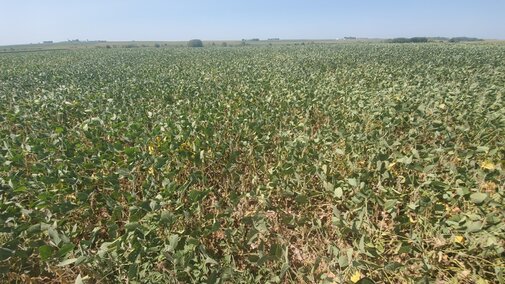For some producers, the time has come to determine if soybean will be cut for forage or left for grain-this is not an easy decision. In some areas, soybean plants are still hanging on despite the continued heat and lack of moisture. The next 10 to 14 days will be critical, as seeds filled inside pods during this timeframe still have a chance of making it to maturity. However, this time to maturity may be reduced if temperatures are warmer than normal.
Major decision points to consider when evaluating whether or not to harvest this year’s soybean crop as grain or forage include:
- What herbicides and insecticides have been used? Many soybean herbicides and insecticides are not labeled for use on soybean as forage. Some herbicides can be toxic to the animal or build up in their body, potentially tainting the meat. It is important to read herbicide and insecticide labels that have been used.
- Contact your crop insurance agent before harvesting soybeans for forage instead of grain.
- On highly erodible land, harvesting soybeans as hay or silage would result in not having enough residue for UDSA program compliance, which would require the additional costs and labor associated with establishing a fall cover crop. Please speak with your local USDA-NRCS conservationist.
- What is the objective for this fall? If you want to plant wheat or a cover crop this fall, it would be best to remove the soybean crop and start moving forward. (Learn more about planting winter wheat after soybeans, or about planting winter hardy forage cover crops.)
- How many pods are set and are they filling? The following is a link for instructions on how to estimate soybean yields including a how-to-video, step-by-step handout guide, and Excel-based calculator. It is even harder than normal to estimate yield on drought-stressed soybeans. So here are few suggested adjustments due to the drought:
- Don’t count pods on the top of the plant that are flat or unfilled. This is help better estimate yield during drought conditions.
- Don’t count a seed in a pod if it is not completely filled when the other one or two are already filled. This will help get a better average seeds per pod estimate.
- Decrease seed size to small or 3500 seeds per pound.
- Increase post yield estimation losses to 20%.
- Are the lower leaves starting to fall off of the plants? If so, you are starting to reduce the potential quality of the forage, as well as yield.
Typically, forage nutritive value of soybean will be similar to alfalfa or slightly lower. Crude protein (CP) should be in the range of 14% to 21%. The energy value based total digestible nutrients (TDN) could be as high as 60%. However, if the leaves have dropped, CP could fall as low as 10 % and TDN will drop accordingly. Forage yield will be highly dependent on past growing conditions, but should be no less than 1 ton per acre, as long as plant are least 12 inches tall.
Soybean hay is challenging to make because the leaves dry quickly, become brittle, and crumble when raked. It is important to harvest soybean before the leaves start to turn yellow and begin to drop. It is especially important to harvest before a freeze to prevent rapid leaf loss. The stems are somewhat woody and dry slowly, so conditioning or crimping when cutting the forage will help to speed up stem drying. Try to avoid raking if possible. If you must rake, especially to put windrows together for baling, try to do it within one day of cutting.
Making good soybean silage is less risky than hay assuming you have access to silage equipment and harvest it properly. For silage, optimum time for harvest is when seeds completely fill the pods and the lower leaves of the plant are just beginning to turn yellow. Prior to this, soybeans will need to be cut and wilted to achieve a moisture target of 65 to 70%.
In general, soybean plants have very little sugar or starch content and do not ferment well when ensiled alone. If possible, mix chopped soybeans with chopped corn or sorghum plants. If mixing corn or sorghum is not an option, it is important to add a silage inoculant for legumes (alfalfa). Additionally, a bushel of rolled corn or 50 pounds of molasses can be added to each ton of wet silage as a fermentation aid. It is critical that soybean silage is well-packed to ensure good fermentation.
The decision to harvest as forage (hay or silage) or grain should be based on economics. We encourage you to assess your need for additional hay and forage, since harvestings soybeans as a forage can have potential complications that we addressed. However, the decision to not harvest soybeans as grain does need to be made as soon as possible to capture the forage value of drought-stressed soybeans.
If you are not committed either way, re-evaluate soybean grain yield potential by mid- September. At that time, you may have a better idea of yield potential since pod set will be determined by then.

